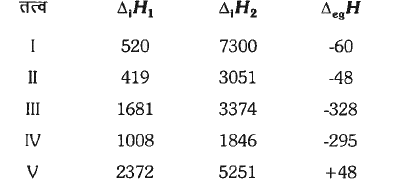I,II,III,IV तथा V तत्वों की प्रथम (△1H1) तथा द्वितीय (△1H2) आयनीकरण एन्थेलपिया (Kj mol−1 में) और इलेक्ट्रान द्वारा प्राप्त एन्थेलपी (△egH)(kJ mol−1) निम्नानुसार दी गयी है 
इनमे से सर्वाधिक क्रियाशील धातु तथा सबसे कम क्रियाशील अघातु क्रमश है
I तथा V
V तथा II
II तथा V
IV तथा V
The correct Answer is:C
प्रतिनिधि Li
II प्रतिनिधि K
III प्रतिनिधि Br
IV प्रतिनिधि I
V प्रतिनिधि He
अंत: इनमे से सर्वधिक क्रियाशील धातु तथा सबसे कम क्रियाशील आधातु प्रदर्शित कर रहे है
Topper's Solved these Questions
- BOOK - ERRORLESS HINDICHAPTER - तत्वों का वर्गीकरण एव गुणधर्मो में आवर्तताEXERCISE - JEE Advanced (More Than One Correct Answers)5videos
तत्वों का वर्गीकरण एव गुणधर्मो में आवर्तता
- BOOK - ERRORLESS HINDICHAPTER - तत्वों का वर्गीकरण एव गुणधर्मो में आवर्तताEXERCISE - JEE Advanced (Reasoning Type Questions)6videos
तत्वों का वर्गीकरण एव गुणधर्मो में आवर्तता
- BOOK - ERRORLESS HINDICHAPTER - तत्वों का वर्गीकरण एव गुणधर्मो में आवर्तताEXERCISE - Multiple Choice Questions (संयोजकता और ऑक्सीकरण अवस्था)35videos
तत्वों का वर्गीकरण एव गुणधर्मो में आवर्तता
- BOOK - ERRORLESS HINDICHAPTER - ठोस अवस्थाEXERCISE - ASSERTION & REASON13videos
ठोस अवस्था
- BOOK - ERRORLESS HINDICHAPTER - तत्वों के निष्कर्षण के सिद्धांत एवं प्रक्रम EXERCISE - Assertion & Reason10videos
तत्वों के निष्कर्षण के सिद्धांत एवं प्रक्रम
Similar Questions
आवर्त सारणी का दीर्घ रूप क्या है?
02:27View Solutionकथन 1 : बेरिलियम की प्रथम आयनन ऊर्जा बोरॉन से अधिक होती है।
कथन 2 : 2p कक्षक की ऊर्जा 2s कक्षक से कम होती है।03:50View Solutionनिम्न में से कौनसा ऑक्साइड उदासीन (Neutral) है
04:53View Solutionप्रक्कथन : हीरा एक कीमती पत्थर है |
कारण : हीरे में कार्बन परमाणु चतुष्कलकीय रुप में व्यवस्थित होते हैं |13:11View Solutionप्रक्कथन : स्वर्ण ऑरोसायनाइड संकुल वाले विलयन से स्वर्ण को जिंक अशुद्धि मिला कर प्राप्त करते हैं।
कारण : जिंक स्वर्ण से अधिक वैद्युत धनात्मक है।04:53View SolutionWhen the first electron gain enthalpy (△egH) of oxygen is −141kJ/mol, its second electron gain enthalpy is :
13:44View Solutionसमान्तर श्रेढियों में से प्रतिमक का प्रथम पद 1 है | तथा उनके सार्व अंतर् क्रमश 1, 2, 3,.......,p है | सिद्ध कीजिए की उनके nवें पाडोकं का योग
12[(n−1)p2+p(n+1)] होगा |03:17View SolutionMg(s)+2HCl (aq) to MgCl_(2) (aq) +H_(2)(g) triangle_(r) H^(@)=-467"kJ/mole" MgO(s)+2HCl(aq) to MgCl_(2) (aq)+H_(2)O(l), triangle_(r)H^(@)=-151"kJ/mole" According to the information and given the fact that for water triangle_(f) H^(@) "=-286 kJ/mole" , what is the triangle_(f)H^(@)" for "Mg0 (s)?
View SolutionCalculate the enthalpy of combustion of benzene (l) on the basis of the following data:
a. Resonance energy of benzene (l)=−152kJ/mol
b. Enthalpy of hydrogenation of cyclohexene (l)=−119kJ/mol
c. ΔfHΘC6H12(l)=−156kJmol−1
d. ΔfHΘofH2O(l)=−285.8kJmol−1
e. ΔfHΘofCO2(g)=−393.5kJmol−102:02View Solutiony2=8x एक परवलय है। मान लीजिए एक त्रिभुज का क्षेत्रफल है जो नाभिलम्ब जीवा के सिरों और परवलय के बिन्दु P(12,2) द्वारा निर्मित है और Δ2 उस त्रिभुज का क्षेत्रफल है, जो बिन्दु P पर और नाभिलम्ब जीवा के सिरों पर खींची गई स्पर्शियों द्वारा बना है। तब Δ1Δ2 है।
02:24View SolutionThe first (Delta_(i)H_(1)) and second (Delta_(i)H_(2)) ionization enthalpies ("in kJ mol"^(-1)) and the electron gain enthalpy (Delta_(eg)H)("in kJ mol"^(-1)) of the elements I, II, III, IV and V are given below the least reactive non - metal and the most reactive metal of these are respectively
04:20View SolutionEnthalpy of formation of NH3 is -X kJ and ΔHH−H, ΔHN−H are respectively Y kJmol−1 and Z kjmol−1. The value of ΔHN=Nis
09:09View SolutionFree energies of formation (△fG) of MgO(s) and CO(g) at 1273 K and 2273 K are given below :
△fGMgO(s)=−941kJ/mol at 1273K△fGMgO(s)=−314kJ/mol at 2273K△fGCO(g)=−439kJ/mol at 1273K△fGCO(g)=−6287kJ/mol at 2273K
On the basis of above data, predict the temperature at which carbon can be used as a reducing agent for MgO (s).View SolutionComment on the thermodynamics stability of NO(g) given that
12N2(g)+12O2(g)→NOg,ΔrHθ=90kJmol−1
NO(g)+12O2(g)→NO2(g),ΔrHθd=−74Kjmol−1View SolutionCalculate the enthalpy change for the process
CCl4(g)→C(g)+4CI(g)
and calculate bond enthalpy of C−Cl∈CCl4(g).
ΔvapHθ(C Cl4)=30.5kJmol−1.
ΔfHθ(Cl4)=−135.5kJmol−1.
Δ0Hθ(C)=715.0kJmol−1, where ΔaHθ is enthalpy of atomisation.
ΔaHθ(Cl2)=242kJmol−1.View Solution

